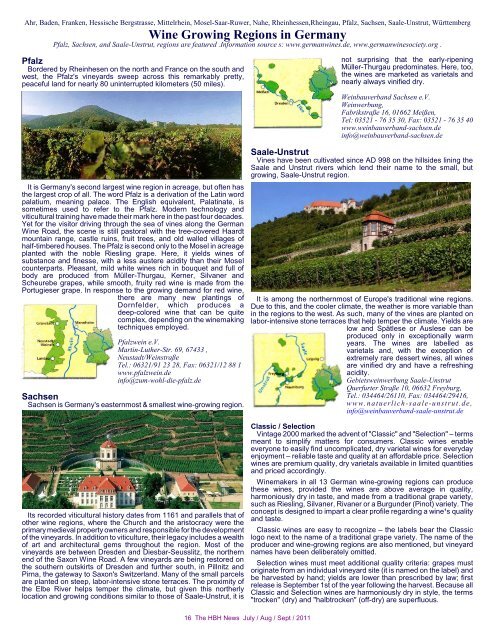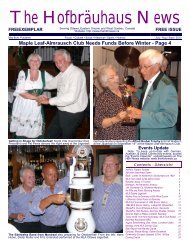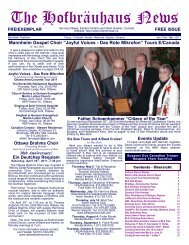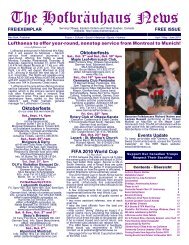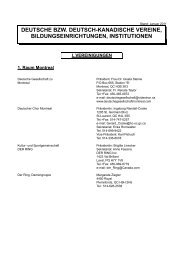The Hofbräuhaus News
The Hofbräuhaus News
The Hofbräuhaus News
You also want an ePaper? Increase the reach of your titles
YUMPU automatically turns print PDFs into web optimized ePapers that Google loves.
Ahr, Baden, Franken, Hessische Bergstrasse, Mittelrhein, Mosel-Saar-Ruwer, Nahe, Rheinhessen,Rheingau, Pfalz, Sachsen, Saale-Unstrut, Württemberg<br />
Wine Growing Regions in Germany<br />
Pfalz, Sachsen, and Saale-Unstrut, regions are featured .Information source s: www.germanwines.de, www.germanwinesociety.org .<br />
Pfalz<br />
Bordered by Rheinhesen on the north and France on the south and<br />
west, the Pfalz's vineyards sweep across this remarkably pretty,<br />
peaceful land for nearly 80 uninterrupted kilometers (50 miles).<br />
It is Germany's second largest wine region in acreage, but often has<br />
the largest crop of all. <strong>The</strong> word Pfalz is a derivation of the Latin word<br />
palatium, meaning palace. <strong>The</strong> English equivalent, Palatinate, is<br />
sometimes used to refer to the Pfalz. Modern technology and<br />
viticultural training have made their mark here in the past four decades.<br />
Yet for the visitor driving through the sea of vines along the German<br />
Wine Road, the scene is still pastoral with the tree-covered Haardt<br />
mountain range, castle ruins, fruit trees, and old walled villages of<br />
half-timbered houses. <strong>The</strong> Pfalz is second only to the Mosel in acreage<br />
planted with the noble Riesling grape. Here, it yields wines of<br />
substance and finesse, with a less austere acidity than their Mosel<br />
counterparts. Pleasant, mild white wines rich in bouquet and full of<br />
body are produced from Müller-Thurgau, Kerner, Silvaner and<br />
Scheurebe grapes, while smooth, fruity red wine is made from the<br />
Portugieser grape. In response to the growing demand for red wine,<br />
there are many new plantings of<br />
Dornfelder, which produces a<br />
deep-colored wine that can be quite<br />
complex, depending on the winemaking<br />
techniques employed.<br />
Pfalzwein e.V.<br />
Martin-Luther-Str. 69, 67433 ,<br />
Neustadt/Weinstraße<br />
Tel.: 06321/91 23 28, Fax: 06321/12 88 1<br />
www.pfalzwein.de<br />
info@zum-wohl-die-pfalz.de<br />
Sachsen<br />
Sachsen is Germany's easternmost & smallest wine-growing region.<br />
Its recorded viticultural history dates from 1161 and parallels that of<br />
other wine regions, where the Church and the aristocracy were the<br />
primary medieval property owners and responsible for the development<br />
of the vineyards. In addition to viticulture, their legacy includes a wealth<br />
of art and architectural gems throughout the region. Most of the<br />
vineyards are between Dresden and Diesbar-Seusslitz, the northern<br />
end of the Saxon Wine Road. A few vineyards are being restored on<br />
the southern outskirts of Dresden and further south, in Pillnitz and<br />
Pirna, the gateway to Saxon's Switzerland. Many of the small parcels<br />
are planted on steep, labor-intensive stone terraces. <strong>The</strong> proximity of<br />
the Elbe River helps temper the climate, but given this northerly<br />
location and growing conditions similar to those of Saale-Unstrut, it is<br />
16 <strong>The</strong> HBH <strong>News</strong> July / Aug / Sept / 2011<br />
not surprising that the early-ripening<br />
Müller-Thurgau predominates. Here, too,<br />
the wines are marketed as varietals and<br />
nearly always vinified dry.<br />
Weinbauverband Sachsen e.V.<br />
Weinwerbung,<br />
Fabrikstraße 16, 01662 Meißen,<br />
Tel: 03521 - 76 35 30, Fax: 03521 - 76 35 40<br />
www.weinbauverband-sachsen.de<br />
info@weinbauverband-sachsen.de<br />
Saale-Unstrut<br />
Vines have been cultivated since AD 998 on the hillsides lining the<br />
Saale and Unstrut rivers which lend their name to the small, but<br />
growing, Saale-Unstrut region.<br />
It is among the northernmost of Europe's traditional wine regions.<br />
Due to this, and the cooler climate, the weather is more variable than<br />
in the regions to the west. As such, many of the vines are planted on<br />
labor-intensive stone terraces that help temper the climate. Yields are<br />
low and Spätlese or Auslese can be<br />
produced only in exceptionally warm<br />
years. <strong>The</strong> wines are labelled as<br />
varietals and, with the exception of<br />
extremely rare dessert wines, all wines<br />
are vinified dry and have a refreshing<br />
acidity.<br />
Gebietsweinwerbung Saale-Unstrut<br />
Querfurter Straße 10, 06632 Freyburg,<br />
Tel.: 034464/26110, Fax: 034464/29416,<br />
w w w . n a tuerlich-saale-unstrut.de,<br />
info@weinbauverband-saale-unstrut.de<br />
Classic / Selection<br />
Vintage 2000 marked the advent of "Classic" and "Selection" – terms<br />
meant to simplify matters for consumers. Classic wines enable<br />
everyone to easily find uncomplicated, dry varietal wines for everyday<br />
enjoyment – reliable taste and quality at an affordable price. Selection<br />
wines are premium quality, dry varietals available in limited quantities<br />
and priced accordingly.<br />
Winemakers in all 13 German wine-growing regions can produce<br />
these wines, provided the wines are above average in quality,<br />
harmoniously dry in taste, and made from a traditional grape variety,<br />
such as Riesling, Silvaner, Rivaner or a Burgunder (Pinot) variety. <strong>The</strong><br />
concept is designed to impart a clear profile regarding a wine¹s quality<br />
and taste.<br />
Classic wines are easy to recognize – the labels bear the Classic<br />
logo next to the name of a traditional grape variety. <strong>The</strong> name of the<br />
producer and wine-growing regions are also mentioned, but vineyard<br />
names have been deliberately omitted.<br />
Selection wines must meet additional quality criteria: grapes must<br />
originate from an individual vineyard site (it is named on the label) and<br />
be harvested by hand; yields are lower than prescribed by law; first<br />
release is September 1st of the year following the harvest. Because all<br />
Classic and Selection wines are harmoniously dry in style, the terms<br />
"trocken" (dry) and "halbtrocken" (off-dry) are superfluous.


